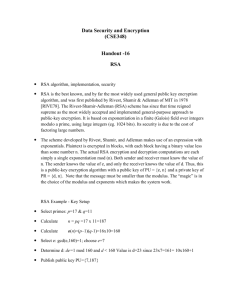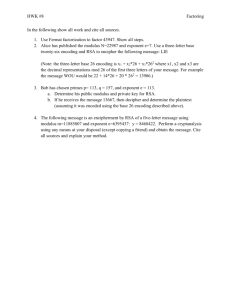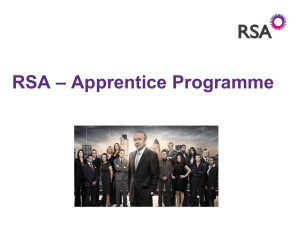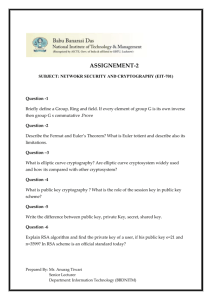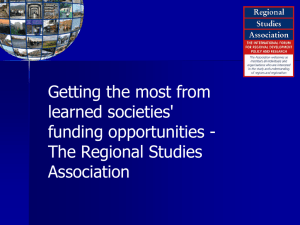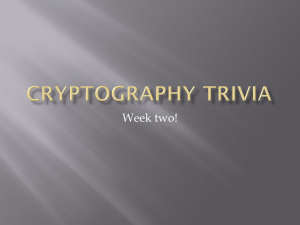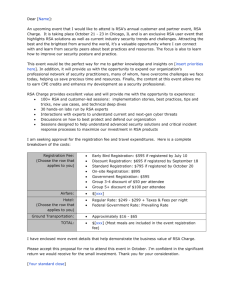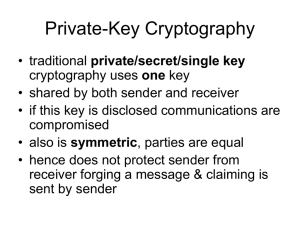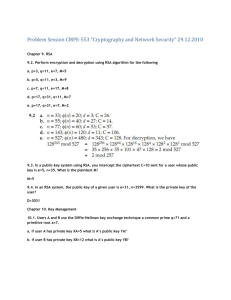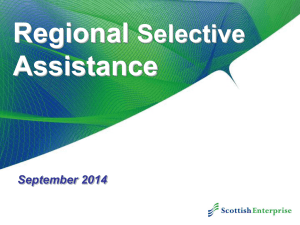ICS 3.23 Case Study Part 2
advertisement
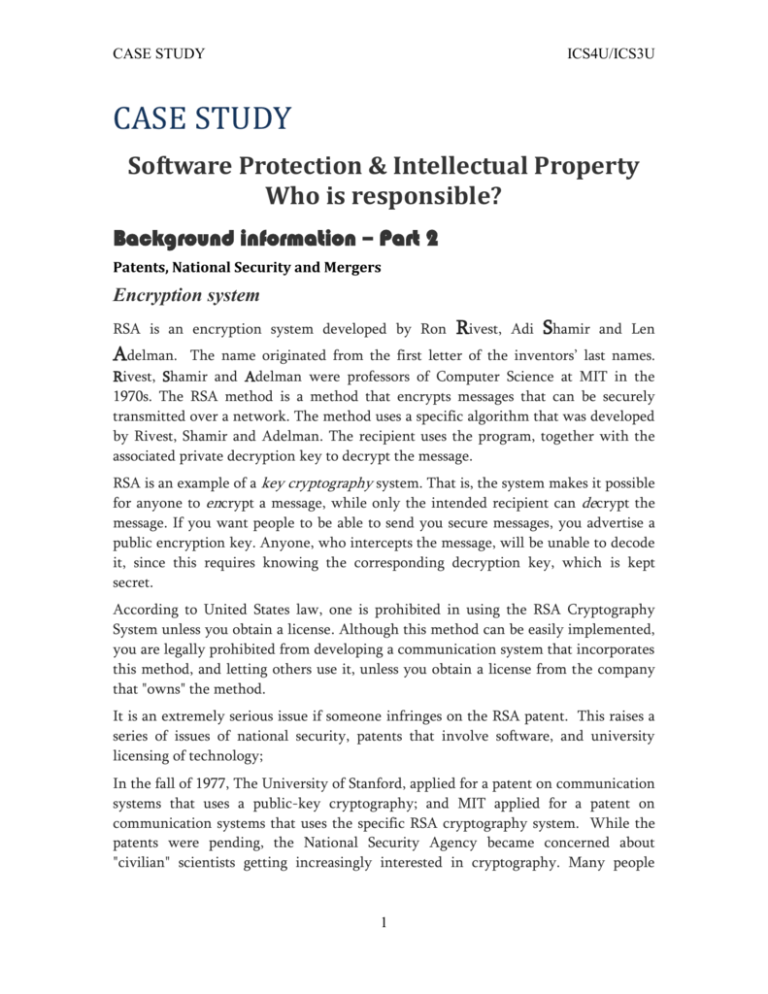
CASE STUDY ICS4U/ICS3U CASE STUDY Software Protection & Intellectual Property Who is responsible? Background information – Part 2 Patents, National Security and Mergers Encryption system RSA is an encryption system developed by Ron Rivest, Adi Shamir and Len Adelman. The name originated from the first letter of the inventors’ last names. Rivest, Shamir and Adelman were professors of Computer Science at MIT in the 1970s. The RSA method is a method that encrypts messages that can be securely transmitted over a network. The method uses a specific algorithm that was developed by Rivest, Shamir and Adelman. The recipient uses the program, together with the associated private decryption key to decrypt the message. RSA is an example of a key cryptography system. That is, the system makes it possible for anyone to encrypt a message, while only the intended recipient can decrypt the message. If you want people to be able to send you secure messages, you advertise a public encryption key. Anyone, who intercepts the message, will be unable to decode it, since this requires knowing the corresponding decryption key, which is kept secret. According to United States law, one is prohibited in using the RSA Cryptography System unless you obtain a license. Although this method can be easily implemented, you are legally prohibited from developing a communication system that incorporates this method, and letting others use it, unless you obtain a license from the company that "owns" the method. It is an extremely serious issue if someone infringes on the RSA patent. This raises a series of issues of national security, patents that involve software, and university licensing of technology; In the fall of 1977, The University of Stanford, applied for a patent on communication systems that uses a public-key cryptography; and MIT applied for a patent on communication systems that uses the specific RSA cryptography system. While the patents were pending, the National Security Agency became concerned about "civilian" scientists getting increasingly interested in cryptography. Many people 1 CASE STUDY ICS4U/ICS3U think this is because the NSA (National Security Agency) was afraid that this would make it easy for people to send messages that can not be decoded by the NSA. Even today, it is illegal to send cryptographic software outside the country. For example, the standard UNIX crypt utility cannot be exported without a special license from the US Government, even though the crypt is based on the encoding method used in the German Enigma machine, which was cracked by Alan Turing and others during World War II. For whatever the reason, the NSA put pressure on MIT to classify the RSA work, or at least to give NSA the right to review and censor further papers in this area. MIT refused to comply with either request. (NSA has since instituted a procedure whereby authors can voluntarily submit papers for review by NSA for possible national security implications.) Systems and Companies Rivest, Shamir, Adelman, the developers of RSA, formed a company called RSA Data Security, and MIT licensed the RSA patent to this company. (The actual details of the original license and its various revisions are confidential. Part of the terms involve royalty payments and stock, MIT now owns about 1% of stock in RSA Data Security.) The MIT license is an exclusive license, which means that MIT has agreed not to license this to anyone else; so anyone wanting to use the RSA method must deal with this one company. (The only exception is that RSA must be made available at no cost "for government purposes." This was a condition of the National Science Foundation contract to MIT, which funded the RSA work.) At about the same time, The University of Stanford licensed a similar patent, also exclusively, to a company called Cylink. Cylink/Stanford accused RSA/MIT of patent infringement, saying that the RSA method, is an implementation of a public-key cryptosystem, infringed the Diffie-Hellman patent, which they claimed covered essentially any public-key system. This raised the possibility of a court fight, and led to confusion about whether people wanting to use the RSA method would have to deal with RSA or Cylink. This problem was soon resolved as both parties agreed to join forces, and in 1990 they formed a third company called Public Key Partners (PKP). PKP would hold both the Stanford and the MIT patents for RSA Data Security and Cylink, which would continue to work on their individual products. MIT and Stanford then renegotiated their licenses exclusively to PKP. Over the past few years, RSA Data Security has developed a line of cryptographic products that use the RSA method, and has marketed these to a wide range of companies, both as stand-alone products and as packages that companies can include in their own systems. They have also been promoting a standard for digital certificates that would support a national system of privacy-enhanced electronic mail over the Internet, with certificates authorized by RSA or its licensees. (This kind of non2 CASE STUDY ICS4U/ICS3U forgeable "digital signature" is also implemented using the RSA algorithm.) You might wonder why anyone needs a standard here, since the whole idea of public-key encryption is that you can publish your personal key and then people can send you messages as they please. But suppose that the public keys are stored in some data file; someone might substitute their public key for yours and intercept mail intended for you. To prevent this, you use a certificate---a kind of key that is "digitally signed" by some authorized person in a way that cannot be forged Licensing People who wish to use the RSA method without using the actual software developed by RSA Data Security must get a license from Public Key Partners, which holds the RSA patent. (PKP and RSA are technically separate companies, but they are closely connected -- the president of RSA is also the president of PKP.) PKP has been threatening people who develop "unauthorized" implementations of RSA or similar algorithms for public use, either commercially or non-commercially. Here, for example, is a letter sent last spring via electronic mail to Mark Riordan, a staff member at Michigan State University. This was followed by a letter to MSU. Riordan had announced the availability of a public domain "privacy enhanced mail system" for use in sending messages over the Internet: May 16, 1991 Dear Mr. Riordan, We refer to your posting to pem-dev@tis.com of May 16, 1991: Announcing the initial release of "rpem", a mostly public domain Privacy Enhanced Mail program incorporating a public key encryption system. The public key encryption algorithm used in rpem is Rabin's: ciphertext = plaintext^2 mod pq (p, q are primes). The public component of the key is pq, and the private component is p and q. Rabin's algorithm is probably slower (on decryption) and less aesthetically pleasing than RSA, for instance, but it's in the public domain. Also, unlike RSA, breaking Rabin's scheme is provably as hard as factoring a product of two primes. The Massachusetts Institute of Technology and the Board of Trustees of the Leland Stanford Junior University have granted Public Key Partners exclusive sublicensing rights to the following patents registered in the United States, and all of their corresponding foreign patents: 3 CASE STUDY ICS4U/ICS3U Cryptographic Apparatus and Method ("Diffie-Hellman") .......................... No. 4,200,770 Public Key Cryptographic Apparatus and Method ("Hellman-Merkle") .......... No. 4,218,582 System and Method ("RSA") .............................. No. 4,405,829 Exponential Cryptographic Apparatusand Method ("Hellman-Pohlig") ............... No. 4,424,414 These patents cover most known methods of practicing the art of public-key cryptography, including the system commonly known as "Rabin," which is NOT, contrary to your claim, public domain, and is covered by at least two of the patents listed above. WE HEREBY PLACE YOU AND ALL USERS OF YOUR IMPLEMENTATION OF PUBLIC KEY, ON NOTICE THAT THEY ARE INFRINGING ON THESE PATENTS AND WE RESERVE ALL OF OUR RIGHTS AND REMEDIES AT LAW. Yours, Public Key Partners Robert B. Fougner, Esq. Director of Licensing This is the kind of letter that many companies send to people they claim are infringing their patents. In general, the US patent system requires the patent holder to pursue patent infringers, or else risk losing the patent rights. 4 CASE STUDY ICS4U/ICS3U Vocabulary Activity Please Define the following words: Patent Merger Infringement Algorithm Cryptography Public Key Cryptography Encrypt Decrypt License 5 CASE STUDY ICS4U/ICS3U Understanding Patents and Security Issues Please answer the following questions: 1. Explain how the public-key cryptography system works 2. What is the National Security Agency? 3. Why is the National Security Agency worried about companies that create cryptography software? 4. Who is Alan Turing? 5. How did PKP come into existence? 6
